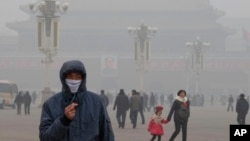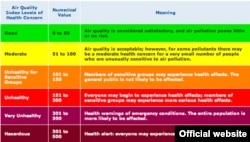The stifling pollution currently plaguing much of northeastern China has reached levels so high it is beyond the measurements used in the U.S. to chart air quality.
“What Beijing is experiencing–and even worse in the provinces–is off the charts from anything we experience in the United States, and likely more than anything we’ve experienced in our country’s history,” said John Walke, the director of the Climate & Clean Air Program at the Natural Resources Defense Council, a Washington, D.C.-based environmental group.
The U.S. measures air quality using a six-color scale indexed from 0-500. The higher the number, the greater and more dangerous the pollution. According to the Environmental Protection Agency, 50 would represent good–or "code green"–air quality, while anything over 300 represents hazardous–or "code maroon"–air quality.
In the summer in Washington, D.C., for example, there may be several days during which pollution reaches 101-150. These are called “code orange” days, meaning the air is deemed unsafe for children and the elderly.
The next level, “code red,” goes from 151-200. Washington may experience a couple of these days in a summer, while a city notorious for poor quality air such as Los Angeles may have a dozen or so, according to Walke.
“The scale above 200 is so rare that we virtually never experience it,” said Walke. “It is deemed very unhealthy.”
Above 200 would be “code purple,” with pollution measuring 201-300; from 301-500 is called “code maroon.” These levels are only seen in the vicinity of large forest fires, Walke said.
On Tuesday, pollution in Beijing reached 517, a number that is considered “beyond index.”
This is according to the U.S. Embassy in Beijing, which is considered the most reliable measurement of air pollution in the city. The embassy has reported pollution as high as 755 earlier this month.
Unsustainable
Higher air quality numbers indicate the presence of more small particles in the air, and Walke explained it’s the smallest particles, the 2.5 micrometer-sized pollution particles, that present the most danger.
“The particles are so small that they can penetrate into the heart, lungs and bloodstream,” he said. “They bypass the body’s natural defense systems and are linked to health ailments like heart attacks, strokes, bronchitis and asthma, chiefly among the elderly.”
According to Dominic Meagher, an economist with China Policy Institute in Beijing, the air quality levels have been hovering around 490 over the past two weeks.
“490 is very hazardous,” he said. “Children are kept indoors, elderly are kept indoors, and healthy people are recommended not to do any physical exercise. It’s not very pleasant.”
The smog was so bad in Zheijiang province that when a furniture factory caught fire earlier this month, the blaze burned for three hours before anyone noticed the smoke.
Indiana University professor Scott Kennedy reported from downtown Beijing that the smog was so bad he could not see the top of the tallest building in the city, the 300-meter World Trade Center Tower III. He added that he could only see about a block and a half down the street.
The Chinese government has shut down over 100 polluting factories and taken a third of all government vehicles off the road, but pollution in Beijing has remained at dangerous levels. According to Meagher, these kinds of temporary, “heavy-fisted” regulations are not a sustainable solution. He said the government is going to have to consider longer and perhaps mandatory regulations to deal with a problem that is very much in the public eye.
“What they’re going to need to do is have a very frank debate about what their options are,” he said. “I imagine it’s going to include strict enforcement of standards on vehicles and factories.”
Meagher also said it would be crucial to get energy companies to increase efficiency standards, something he said they have been reluctant to do.
VOA's Victor Beattie contributed to this report.
“What Beijing is experiencing–and even worse in the provinces–is off the charts from anything we experience in the United States, and likely more than anything we’ve experienced in our country’s history,” said John Walke, the director of the Climate & Clean Air Program at the Natural Resources Defense Council, a Washington, D.C.-based environmental group.
The U.S. measures air quality using a six-color scale indexed from 0-500. The higher the number, the greater and more dangerous the pollution. According to the Environmental Protection Agency, 50 would represent good–or "code green"–air quality, while anything over 300 represents hazardous–or "code maroon"–air quality.
In the summer in Washington, D.C., for example, there may be several days during which pollution reaches 101-150. These are called “code orange” days, meaning the air is deemed unsafe for children and the elderly.
The next level, “code red,” goes from 151-200. Washington may experience a couple of these days in a summer, while a city notorious for poor quality air such as Los Angeles may have a dozen or so, according to Walke.
“The scale above 200 is so rare that we virtually never experience it,” said Walke. “It is deemed very unhealthy.”
Above 200 would be “code purple,” with pollution measuring 201-300; from 301-500 is called “code maroon.” These levels are only seen in the vicinity of large forest fires, Walke said.
On Tuesday, pollution in Beijing reached 517, a number that is considered “beyond index.”
This is according to the U.S. Embassy in Beijing, which is considered the most reliable measurement of air pollution in the city. The embassy has reported pollution as high as 755 earlier this month.
Unsustainable
Higher air quality numbers indicate the presence of more small particles in the air, and Walke explained it’s the smallest particles, the 2.5 micrometer-sized pollution particles, that present the most danger.
“The particles are so small that they can penetrate into the heart, lungs and bloodstream,” he said. “They bypass the body’s natural defense systems and are linked to health ailments like heart attacks, strokes, bronchitis and asthma, chiefly among the elderly.”
According to Dominic Meagher, an economist with China Policy Institute in Beijing, the air quality levels have been hovering around 490 over the past two weeks.
“490 is very hazardous,” he said. “Children are kept indoors, elderly are kept indoors, and healthy people are recommended not to do any physical exercise. It’s not very pleasant.”
The smog was so bad in Zheijiang province that when a furniture factory caught fire earlier this month, the blaze burned for three hours before anyone noticed the smoke.
Indiana University professor Scott Kennedy reported from downtown Beijing that the smog was so bad he could not see the top of the tallest building in the city, the 300-meter World Trade Center Tower III. He added that he could only see about a block and a half down the street.
The Chinese government has shut down over 100 polluting factories and taken a third of all government vehicles off the road, but pollution in Beijing has remained at dangerous levels. According to Meagher, these kinds of temporary, “heavy-fisted” regulations are not a sustainable solution. He said the government is going to have to consider longer and perhaps mandatory regulations to deal with a problem that is very much in the public eye.
“What they’re going to need to do is have a very frank debate about what their options are,” he said. “I imagine it’s going to include strict enforcement of standards on vehicles and factories.”
Meagher also said it would be crucial to get energy companies to increase efficiency standards, something he said they have been reluctant to do.
VOA's Victor Beattie contributed to this report.












